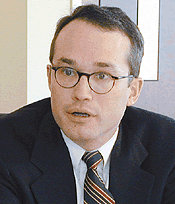Economy May Drive Rates Higher
 | |
| More coverage | |
| |
 |
Smith expects increases of 5% to 10% in truckload rates. “If we are unable to receive rate increases, I see service deteriorating,” he said.
“We think rate increases are coming,” said Donald Broughton, senior analyst at A.G. Edwards & Sons, “but they are not coming for trucking companies, they are coming for drivers.”
The key to producing better returns for trucking companies will be using equipment efficiently.
“Trucking companies that can produce the highest rates of asset turnover, or asset utilization, are going to be able to get the drivers . . . and trucking companies that produce high rates of asset utilization have more flexibility in producing financial returns,” Broughton said at Transport Topics’ annual management forum.
 |  Michael James - Transport Topics |
 | A.G. Edwards & Sons senior analyst Donald Broughton |
“I think shippers are willing to partner with their providers in the form of either reducing costs to allow the carrier to make more money at the current rate or to get an increased rate,” he said.
Overall, Scherck predicted increased yields, or revenue per pound, of only 2% in 2000, which is below the projected rate of inflation.
“What you’re seeing is a change in mix — more products are lighter, moving in smaller quantities — therefore they command a higher rate per pound because they are at a lower weight break.”
Smith and Broughton, however, think the time is right for carriers to secure higher rates.
“If we are going to provide [shippers] with the capacity they need, we are going to need more money,” Smith said.
“I think John is absolutely right,” Broughton added, citing overall economic growth and shipper surveys as reasons for optimism.
“I am convinced that there is room for price increases,” he said. “The response we have gotten from a number of major shippers is: ‘If the company could just guarantee me more power, I’d be more than willing to pay them a little higher rate.’ ”
To offset higher costs, both shippers and carriers will be looking for ways to improve productivity.
 Michael James - Transport Topics |  |
| CRST Intl. President John M. Smith |  |
Some carriers, instead of raising rates, are charging a detention fee if drivers are held up at loading docks or trailers are left empty for too long a period of time.
“We are able to come off lanes which were not profitable and get into lanes in which we are, and a lot of that has to do with waiting time,” Smith said. “Over time, I think people will either price it correctly or get more detention time and things like that. Instead of a rate increase, if you charge detention, you’ve taken a huge rate increase.”
One major shipper, Procter & Gamble Co., offers a discount to customers who unload products within two hours.
That, said Broughton, “is dramatically different than what we would have seen just a couple years ago.”
Reducing waiting time is a key to improving asset utilization and carrier profitability, he said.
 |
“And to the shipper who screams ‘How can you charge me that rate?’ you show him the data. Either the shipper works with you or that business goes to one of your competitors, and he is essentially hauling unprofitable freight, which doesn’t solve the problem quickly, but the marketplace over a number of years takes care of that competitor.”

